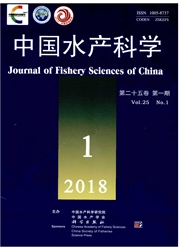

 中文摘要:
中文摘要:
采用RACE技术克隆获得中国明对虾(Fenneropenaeus chinensis)丝裂原活化蛋白激酶激酶3(MKK3)基因全长cDNA序列,并对该序列进行分析。结果表明,该基因全长为1434bp,开放阅读框长1011bp,5,非编码区长33bp,3'非编码区长390bp,将该基因命名为FcMKK3。推测该基因编码336个氨基酸,分子量为37.89kD,理论等电点为6.08。同源性和系统进化分析表明,FcMKK3基因与丽蝇蛹集金小蜂(Nasonia vitripennis)和地中海实蝇(Ceratitis capitata)的相似性分别为69%和68%,与其他节肢动物MKK3聚为一类。荧光定量RT-PCR结果表明,FeMKK3基因在肌肉中的相对表达量最高,其次为鳃。氨氮胁迫后该基因在中同明对虾肠、鳃、胃、心脏、肝胰腺、肌肉和血细胞中的表达量均显著增加,并有不同的时空表达趋势,表明FcMKK3基因可能在中国明对虾应对非生物胁迫反应的过程中起着重要的作用。
 英文摘要:
英文摘要:
We cloned the full-length mitogen activated protein kinase kinase 3 (MKK3) eDNA sequence using the rapid amplification of eDNA ends method to understand the physieoehemical and functional characteristics of MKK3 in Fenneropenaeus chinensis. F chinensis MKK3 was analyzed using a bioinformatics method to explore the sequence homology of MKK3 genes from different species. MKK3 gene expression levels were determined in different tissues by quantitative real-time polymerase chain reaction analysis before and after exposure to ammo- nia-N stress. The full-length eDNA sequence of the F chinensis MKK3 gene (FcMKK3) was 1434 bp long and contained a 33 bp 5'-untranslated region (UTR), a 390-bp 3'-UTR, and a 1011-bp open reading frame that encoded 336 amino acid residues, with an isoelectric point (PI) of 6.08 and molecular mass of 37.89 kD. The homology analysis revealed that the FcMKK3 amino acid sequence had highly similarity with MKK3 of other species, such as 69% identity with Nasonia vitripennis MKK3 and 68% identity with Ceratitis capitata MKK3. The phyloge- netic analysis showed that FcMKK3 was in the same class with other arthropod MKK3 genes. The FcMKK3 gene was expressed in intestine, gill, stomach, heart, lymph, hepatopancreas, muscle, and hemocytes, with significant differences in tissue expression levels. Relative expression of FcMKK3 in muscle was the highest, followed by the gill. FcMKK3 expression in hemocytes was the lowest. FcMKK3 expression after exposure to ammonia-N stress was initially upregulated in intestine, gill, stomach, and muscle and then downregulated, followed by upregulation. FcMKK3 expression reached the first peak at 6 h, 6 h, 6 h, and 3 h in intestine, gill, stomach, and muscle, respec- tively, which was 2.33-fold (P〈0.01), 1.56-fold (P〈0.01), 2.99-fold (P〈0.01), and 1.56-fold (P〈0.01) of the four tissues in control animals, respectively. The second peak was reached at 96 h, 72 h, 72 h, and 48 h, which was 2.49-fold (P〈0.01), 2.34-fold (
 同期刊论文项目
同期刊论文项目
 同项目期刊论文
同项目期刊论文
 Comparison of growth and development patterns of Fenneropenaeus chinensis(Osbeck) “Huanghai No.1” an
Comparison of growth and development patterns of Fenneropenaeus chinensis(Osbeck) “Huanghai No.1” an Sequence variation in theFarnesoic acid O-Methyltransferase (FAMeT) gene and its associations with g
Sequence variation in theFarnesoic acid O-Methyltransferase (FAMeT) gene and its associations with g 期刊信息
期刊信息
